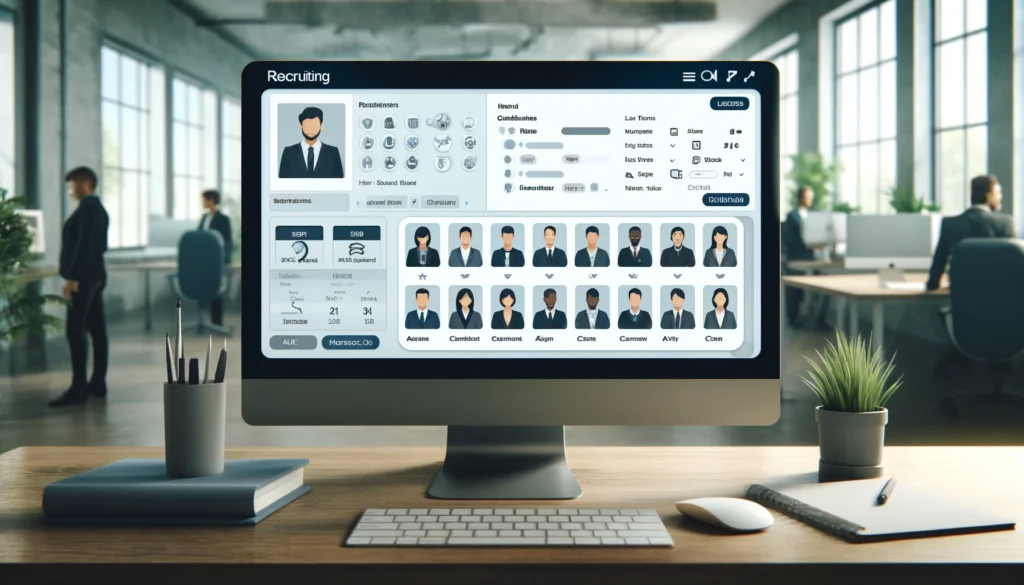In the current world of increased competition for talent, the use of automated talent sourcing techniques has become paramount for recruiters. Automated sourcing is the application of technology in candidate search and screening to enable talent acquisition professionals to find and engage the best candidates. In this article, we are going to discuss new trends in automated talent sourcing and how they can be used to get an advantage over competitors, attract the right professionals, and create a deep and strong talent pool for the long term. Applying automation in candidate sourcing is not only effective in terms of time and costs but also provides a more objective approach to talent acquisition.
Define Your Ideal Candidate Persona
An ideal candidate profile is a document that is used by the hiring team in order to identify the most suitable candidate for a certain position. It encompasses all the desirable competencies, education, and character traits that a candidate should possess to meet the organizational needs of the position and the organizational culture of the company. It is important to note that the identification of the ideal candidate persona is critical when it comes to the use of automation in talent acquisition.
Identify the skills, qualifications, and traits of your ideal candidate
In this case, the candidate must have the right education and experience to perform the job well and meet the objectives of the company. For each open position, there will be a list of the job-specific hard skills, which include understanding of specific applications, processes, problem-solving abilities and technical proficiency. Also, there are communication, interpersonal, leadership, problem-solving, initiative, and emotional intelligence skills that each employee should possess, such as time management, understanding of others, critical thinking, initiative, and self-awareness.
Other essential qualities and characteristics that your ideal candidate should have include the following personality traits and attributes that should reflect the company’s culture and beliefs. The best candidates are self-motivated and self-starters who do not require constant encouragement and direction in order to complete their tasks. It should be based on moral/ethical values, professionalism, integrity, truthfulness, discretion, credibility, and dependability. In addition, your ideal candidate should be a team player, possess good communication and interpersonal skills, and have the ability to solve problems without resorting to violence.
Research industry trends and job requirements
To be more specific, you should conduct research, which will help you understand what competencies and skills are expected from the candidate in your field and industry. It is also important to look at similar positions in competitors’ organizations in order to determine the job descriptions and specifications they provide. Read through the job descriptions provided and ask questions to ensure you have a good understanding of what the job requires.
In addition, refer to your hiring metrics on analytics and other data points in your hiring dashboard to establish if there are any other KPIs that would be significant for your candidate profile. Use the information gathered from various sources such as industry and market research, internal stakeholders, and recruitment data to develop a clear picture of the ideal candidate persona.
In this way, the ideal candidate persona will be well-defined and will act as a guideline for the automated talent sourcing processes, allowing you to find and engage the best candidates for your company.
Try PreScreen AI for Free
Don’t miss out on the opportunity to experience all the benefits of AI-powered interviews firsthand – try our free trial today.
Measure and Analyze Sourcing Metrics

Track response rates and conversion rates
By analyzing the response rates and conversion rates, recruiters will be able to determine whether or not automated talent sourcing is effective. The click-to-apply ratio represents the share of candidates who click through a job listing, and then apply for the position. According to the data, in 2023, the click-to-apply CTR across all industries stood at 5%, which means that employers are increasingly turning candidates into applicants.
The applicant-to-interview ratio is the ratio of number of applicants to the number of interviews offered. In 2023, the applicant-to-interview ratio was 2%, which means that only two applicants were selected for an interview out of one hundred applicants. This low ratio may be attributed to the fact that the organization hires unqualified candidates or that there is interview ghosting that slows down the hiring process.
In addition, the interview-to-hire ratio of 36% in 2023 reflects the proportion of candidates who were interviewed and subsequently hired. Although this ratio is slightly down from the previous year, the high conversion rate of the interview stage indicates that employers are effective at identifying the right candidate at a later stage in the process.
Identify top-performing sourcing channels
Evaluating the performance of the different sourcing methods is very important in determining the right automated talent sourcing approach. Recruiters should consider the number of potential candidates that are likely to be reached by each recruitment channel and the conversion rates. Using the percentage of applications and the percentage of job posting impressions, it is easy to determine the effectiveness of the different channels.
Using Google Analytics, it is possible to identify sources of website visitors who viewed jobs and applied. This data can provide information, for example, that candidates from a particular platform, for instance, LinkedIn or Facebook, are more inclined to apply for the position.
Furthermore, the cost of the sourcing channels should be evaluated with regard to advertising costs. By dividing the advertising spend by the number of successful applicants from a specific channel, the sourcing channel cost per hire can be derived for a cost-benefit analysis.
Monitor time-to-fill and cost-per-hire
Time-to-fill is a measure of the number of calendar days it takes to fill a position from the time the position is posted on the company’s website to the time the candidate accepts the offer. This metric is sometimes presented as an average number of days when divided by the total number of hires or positions. The SHRM states that the average time-to-fill is 36 days, although this can be much longer or shorter depending on the industry and position.
Time-to-hire refers to the number of days between the time a candidate applies for a job or is contacted and the time he or she accepts the offer. This metric shows the rate at which recruiters are able to identify and progress the top candidates through the recruitment funnel. The time-to-hire should be minimized as much as possible because the most qualified candidates are usually snapped up within 10 days.
In order to decrease time-to-fill and time-to-hire, the recruiters should divide the whole process into several steps, and then analyze the time spent on each of them as well as possible reasons for delays. Furthermore, the use of templates and efficient correspondence with candidates can also contribute to reducing the overall time for the hiring process.
Another important metric that is also used is the cost per hire; this is the total cost that is incurred in the hiring process divided by the number of hires. This metric covers internal and external costs and offers valuable information about the effectiveness of the recruitment process.
Through the regular tracking and evaluation of these key sourcing indicators, recruiters can get crucial insights into the performance of their automated talent sourcing solutions, discover opportunities for improvement, and make evidence-based decisions to enhance their recruitment workflows.
Try PreScreen AI for Free
Don’t miss out on the opportunity to experience all the benefits of AI-powered interviews firsthand – try our free trial today.
Leverage Recruiting Technology

Utilize applicant tracking systems (ATS)
Applicant tracking systems should be used by recruiters in order to manage and automate many aspects of the recruitment process. ATS is a software tool that enables companies to store candidates for the purpose of hiring and recruiting, providing businesses with the means to gather candidate data, categorize prospects according to experience and skill, and sort applicants.
More than 95% of Fortune 500 companies today employ an ATS to sort and track candidates who seek jobs in their organizations. Although a conventional ATS is quite useful for archiving candidate data, the most advanced applicant tracking systems of today integrate seamlessly with other talent acquisition solutions, including candidate relationship management systems (CRMs) for sourcing, communicating with, and engaging with prospective candidates more effectively, as well as interviewing and evaluating them.
An ideal ATS improves the efficiency of the TA teams by automating the process of sourcing, communicating with, interviewing, and moving through qualified candidates. As open positions may receive thousands of applications regardless of the work experience, education, and certifications, automation helps companies and recruiters save time that otherwise would be spent on rejecting candidates. necessary work experience, education, and certifications, automation saves companies and recruiters time that would otherwise be spent manually weeding out these job applicants.
Some key features to look for in an ATS include:
- Posting job openings on career sites and job boards
- Connecting with candidates on social media (e.g., LinkedIn)
- Building relationships with interested candidates
- Assessing employee referrals and internal talent
- Nurturing job seekers through the recruiting funnel
- Scheduling interviews with potential candidates
- Converting late-stage applicants into new hires
- Rediscovering top talent or silver medalists
- Analyzing real-time updates and making data-driven decisions
By integrating the most effective ATS solutions, companies can enhance key recruiting KPIs, including pipeline velocity, interview time, cost per hire, and candidate quality. Also, direct connections with other recruiting applications and human resource management systems (HRMS) allow talent acquisition teams to transfer data between their ATS and other hiring solutions, providing stakeholders with pipeline progress snapshots and ensuring the critical candidate data is shared between systems.
Implement AI-powered candidate matching
Candidate matching and selection is another area where the use of AI is on the rise, as 32% of the respondents in the IDC survey said that it is the primary use of AI in their organization. AI-based recruiting products can look for candidates in many sources at once, build more diverse talent pools, and automatically compare and sort candidates for the jobs.
Candidate matching technologies include machine learning algorithms and natural language processing to match application documents (résumés) and job descriptions, offering a measure of similarity between the candidate and the job. This technology extracts skills from a candidate’s background documentation, skills that the candidate may have forgotten to mention, thus making the comparison of the candidate’s qualifications more effective.
However, it is crucial not to exclude a candidate based on the AI’s suggestion but to use it as a tool that assists in the decision-making process.
Try PreScreen AI for Free
Don’t miss out on the opportunity to experience all the benefits of AI-powered interviews firsthand – try our free trial today.
Automate sourcing and outreach processes
The use of automated methods in the sourcing and outreach activities can improve the overall effectiveness of talent acquisition strategies. Recruiting automation tools can help to write job descriptions, get candidate lists, contact the candidates, and schedule the calls, which helps to reduce the time needed for the candidate search.
Tools like Mailchimp, SendGrid, HubSpot help in sending multiple job invitations and follow-up messages, as it is not possible to type each interaction individually. These platforms can use the candidate’s name or some details from the profile in the message, which makes a great difference from the regular emails sent in bulk.
CRM systems like Bullhorn, Zoho Recruit, and Salesforce are useful in outreach automation because they act as a master database of all the candidate information and all the touchpoints, from the first conversation to the next interview. These systems make the recruitment process easier with tracking and communication features to make sure no candidate is missed and also to ease the process of managing multiple candidates throughout the recruitment pipeline.
Automation tools also include analytics, which can display such data as email open rates, click-through rates, and job posting views, which can help recruiters determine what attracts candidates and what should be changed. Also, automation reduces recruitment costs and makes the process more efficient for organizations, especially when dealing with a large number of candidates.
Applicant tracking systems (ATS), AI candidate matching, and automation of sourcing and outreach can provide recruiters an edge, identify and engage passive candidates before competitors, access a more diverse and niche talent pool, and transform from transactional to strategic partners to the business by offering talent intelligence, workforce planning, and retention strategies.
Use Conversational AI to Prescreen Candidates
Conversational AI voicebots have become a new trend in talent sourcing in the current society. These advanced technologies have made it easier for recruiters and HR professionals to find out the potential candidates to be hired. With the help of artificial intelligence, voicebots can engage candidates in a conversation, ask tailored questions, understand the answers, and assess them. This not only benefits the recruiters by saving time and effort but also improves the candidate experience.
The first advantage of of employing AI voicebots in talent sourcing is that it can help the organization to screen candidates without human intervention. In the case of using AI voicebots, this process becomes much more efficient. It is not necessary to create a list of questions that would allow to prescreen candidates. These voicebots can scan through resumes and job descriptions, set questions as well as carry out initial screening to establish the appropriateness of a candidate for a certain position. The interaction of the candidate with the AI voicebot is done through oral and written questions and answers. The AI voicebot is designed to use natural language processing algorithms to interpret the candidate’s answers and their fit for the position.
The other benefit of implementing AI voicebots in talent sourcing is that they give a non-prejudiced and standardized approach. There is a high probability that human recruiters will be biased during the screening process and thus compromise the treatment of the candidates. In contrast, AI voicebots are guided by certain parameters and do not have any prejudice or bias towards anything. They do not consider any other factors apart from the qualifications and answers provided by the candidates, thus making the process fair. This assists organizations in the development of a diverse and inclusive workforce.
Try PreScreen AI for Free
Don’t miss out on the opportunity to experience all the benefits of AI-powered interviews firsthand – try our free trial today.
Concluding Remarks
In today’s world of employment competition, it is crucial for recruiters to master new automated talent sourcing techniques. The effective identification of ideal candidate personas, the use of multiple sourcing methods, effective candidate communication, candidate nurturing, the tracking of key metrics, and the adoption of advanced recruitment technologies allow organizations to achieve a competitive advantage in the talent acquisition process.
In conclusion, automated talent sourcing is beneficial when it comes to selecting and attracting the right talent for the organization through a strong talent pipeline that is in line with the organization’s needs and values. Those employers who adopt these approaches can place themselves as strategic business partners, who can help achieve sustainable organizational goals through evidence-based decision making, workforce planning, and sound employee attraction and retention policies.
Related Articles
How Top Companies Use AI to Automate the Hiring Process and Boost HR Collaboration
Discover how AI is revolutionizing collaboration between HR and hiring managers by automating the hiring process. Explore...
Customizing AI Recruitment Bots for Different Industries
Discover how customizing AI recruitment tools meets the unique needs of various industries, explore industry-specific AI recruitment...
Leading AI Tools for Candidate Screening and Qualifying in 2024
A survey conducted with HR professionals revealed that about 67% of the respondents hold a positive view...




